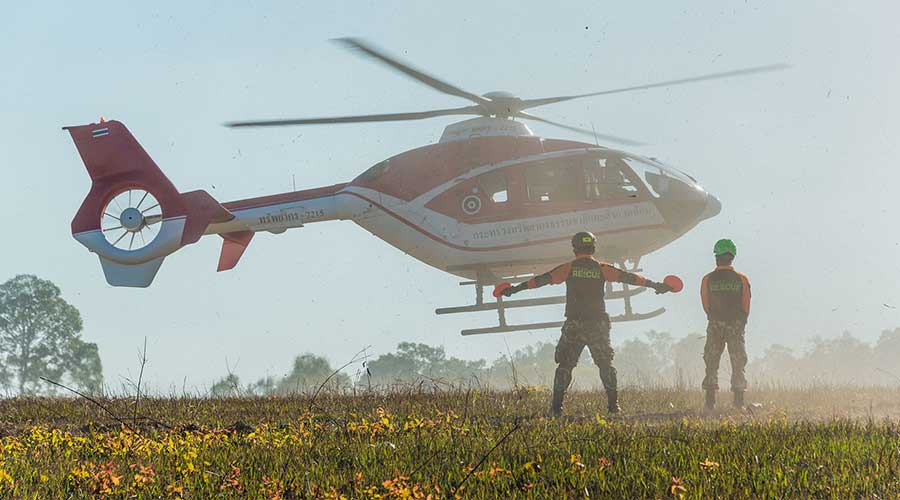
3 Ways Mobile Recording Improves Disaster Preparedness
HOW MOBILE RECORDING CAN IMPROVE YOUR DISASTER TRAINING
If there’s a massive pileup on the freeway and 50 injured patients head to your emergency room, will you be ready to receive and treat them? If an earthquake damages your corporate offices, do you know how to evacuate everyone quickly and safely? If a military helicopter collides with a commercial airliner at your airport, are you prepared to coordinate a multi-agency response? Just as simulation training has become an integral part of healthcare education, it is increasingly used in disaster preparedness training as well.
Realistic and immersive disaster drills help refine processes and help healthcare professionals and other responders learn what it would really be like to respond to a large-scale disaster, whether natural or otherwise. Many hospitals even hire local actors or nursing students to play patients, complete with bloody makeup and torn clothes. But once the adrenaline has faded and the disaster has been dealt with, how do you review what went right, as well as learn from what could have gone better? “In simulation, using video recording as a tool is invaluable,” said Brandon Phillips, a former EMT and current simulation technology and operation specialist with Level 3 Audiovisual. "We can capture an entire event. We can utilize bookmarking and timestamping so we know when specific events occurred within the simulation--either things the team can improve on or that they did really well." Mobile recording and video debriefing have been incorporated into many simulation lab environments, the tools are currently underutilized in the disaster preparedness space. Here are three reasons that should change.
3 REASONS YOUR DISASTER PREPAREDNESS PROGRAM NEEDS MOBILE RECORDING
- Professionals make mistakes—but they might not know it. Even healthcare veterans can be surprised by the procedural mistakes they make and bad habits they’ve developed when they see themselves on camera. “No one likes being recorded, and no one wants to look inferior in front of their peers,” Brandon said. “But people get over it pretty quickly. Everyone has these little nuances to what they do and when they can watch themselves, they can really see what their process is.” Without the benefit of a recording of a real-time disaster response, those errors might never be detected and corrected.
- Disaster preparedness takes a team—and teams need to learn to work together. In real disasters, the response can involve multiple agencies including law enforcement, fire departments, search and rescue, emergency responders, and even the military. The benefit of disaster preparedness training is to give all those people a chance to practice working together. In the heat of the moment, everyone’s focus may revert to their own tasks and not the larger picture. A recording of the event gives a comprehensive view of the entire response effort and can help participants from every agency and organization see ways they can improve their collaboration—as well as see ways they worked well together.
- Lessons and best practices should be identified and applied immediately. Simply recording a disaster preparedness drill on a couple camera phones doesn’t facilitate immediate debriefing of the exercise. It would take hours—if not days—to sift through multiple streams of video footage to find the relevant teaching moments. Visiting participants may miss out, and if addressed days later, the impact of the simulation and value of the lesson could be gone.
NEXT STEPS
There is a mobile recording and debriefing solution that can maximize the benefits of your disaster simulations. Level 3 Audiovisual’s SIMStation Essential is the first-ever mobile high-end video-debriefing system. The solution:
- Supports up to three cameras, two fixed and one point-to-zoom with a 30x optical zoom capability. Together these cameras—each connected to a provided ethernet cord that stretches 300 feet—can easily cover your entire simulation area, whether indoors or outdoors.
- Features timestamping and bookmarking capabilities that allow you to easily flag parts of the simulation you want to come back to during debriefing.
- Includes SIMStation recording and debriefing software, which can be run from a laptop or tablet.
- Features a high-quality interface microphone to ensure the best recording quality.
- Expands and is available in a pro version that supports an unlimited number of cameras and includes higher-resolution video. You can also opt for add-ons like a media screen so simulation participants can receive and view x-rays, lab results, or live updates from the CDC as part of the exercise.
All the Essential components fit into a 3x2-foot case, making it highly portable. “It’s something the whole disaster preparedness community is missing out on,” said Brandon. “Having our system would be a huge help in getting your staff trained. That solidified learning that we do in simulation is kind of becoming the gold standard in terms of healthcare and learning, and our system is really great to aid with that.” Ready to lead the way in disaster preparedness training with SIMStation Essential? Chat with us at the bottom of your screen or Get in touch for a demo or more information!

